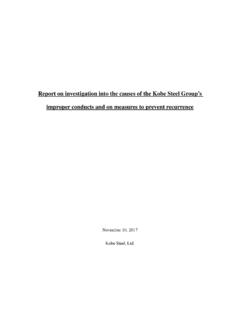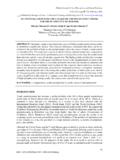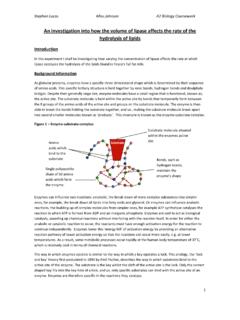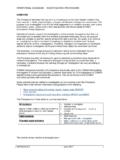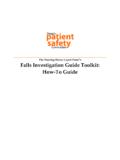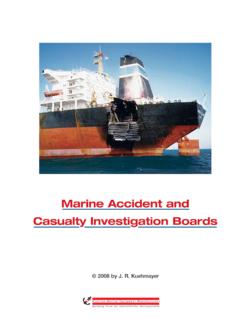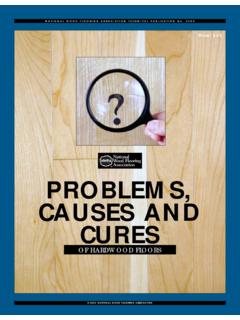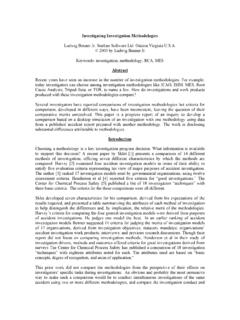Transcription of PIARC ROAD ACCIDENT INVESTIGATION GUIDELINES FOR …
1 PIARC road ACCIDENT INVESTIGATION GUIDELINES FOR road ENGINEERS August 2007 AUTHORS STATEMENTS This guideline has been prepared by the World road Association PIARC Technical Committee - road Safety , within the frame of activity for working group 1 Making cost effective road safety investment . The team members to the preparation of this guideline are: Team Leader: Josef Mikul k, CDV Transport Research Centre, the Czech Republic email: Deputy Team Leader: P ter Holl , KTI Institute for Transport Sciences, Hungary (Chapter 5) email: Member: Sabine Degener, GDV German Insurance Association, Germany Member: Tawandar Mdawarima, Ministry of Transport and Communication, Zimbabwe Member: Krzystof Kowalski, road and Motorway Directorate, Poland Member: Peter , GRSP, the Netherlands Valuable comments to the draft were received from other TC road Safety TC members including Phil Allan (Australia), L rus ugustsson (Denmark) and Tamra Fedojuk (Australia).
2 The CDV team consisting of Jaroslav Heinrich, Josef Pokorn , Josef Andr s, Pavel Skl dan , Vojt ch Eksler, Roman Striegler and Milan Dont has developed a significant contribution to the GUIDELINES from within the project Sustainable Transport an opportunity for Future financed by the Czech Ministry of Transport. James Arthur Norwood (USA, interned CDV) has helped with the English language, and quality control. The road Safety - Technical Committee was chaired by Hans-Joachim Vollpracht (Germany). Beth Alicandri (USA), Patrick Mallejacq (France), Roberto Hamas Rubio (Spain) served as respective English, French and Spanish speaking secretaries. 2 Table of content 1. WHAT IS A road ACCIDENT INVESTIGATION (RAI)..4 road ACCIDENT INVESTIGATION (RAI) and road Safety Inspection (RSI)..5 2. THE road A SIGNIFICANT FACTOR IN THE SAFETY 3. ACCIDENT Need of Data parameters and their Minimum road and traffic Additional 4.
3 ACCIDENT General Route km post; Node 5. ACCIDENTS DATA 6. TYPES OF 7. COLLISION 22 Introductory Fundamentals for creating collision 8. EVALUATION OF COLLISION DIAGRAMS FOR SAFETY General Practice Before/after graphic 9. APPENDICES: 1. NETWORK SAFETY MANAGEMENT (GERMANY) 2. ASSESSMENT OF road SECTION SAFETY (THE CZECH REPUBLIC) 3. road ACCIDENT TYPOLOGY 4. POSSIBLE LINKS AMONG ACCIDENT TYPE, ACCIDENT CAUSE AND road DEFICIENCY 5. SIGNS AND SYMBOLS USED IN COLLISION DIAGRAMS 6. EXAMPLES OF COLLISION DIAGRAMS FOR DETECTING road DEFICIENCIES 3 1. WHAT IS A road ACCIDENT INVESTIGATION (RAI) Definition A road ACCIDENT INVESTIGATION (RAI) is a set of procedures carried out on existing roads which includes: a collection of information about accidents and about all the facts linked to them, about road and traffic parameters and other related circumstances ( driver behaviour and his/her impairment, weather and light conditions, etc.)
4 An assessment of the ACCIDENT distribution on the road network, on the particular road or road section/location a detailed data analysis of accidents and their circumstances in the targeted spots/sections of roads by using collision diagrams a determination of the road related deficiencies and elaboration of suggestions for their suppression or treatment Carrying out the RAI requires a certain amount of ACCIDENT and the accompanying data according to the road engineer s given task. A typical task is to draft a preference list of improvement interventions or of black spot treatments. The purpose of the RAI is to help road engineers detect the amount of road infrastructure deficiencies that influence an ACCIDENT s occurrence, and to guide them in the implementation of appropriate improvement measures. The RAI is based on findings compiled in the road Safety Manual ( PIARC , 2003), and upon particular later developments as described in Chapter 4, 5, and 6 of Part 2 of this manual.
5 4 road ACCIDENT INVESTIGATION (RAI) and road Safety Inspection (RSI) RAI and RSI both deal with existing roads. Given that the RSI procedure doesn t require any data input, the investigators need expert qualification and experienced in road safety. Their evaluation of the risk features of the road and its environs is not only an identification of the hazardous situation, but also draws attention to locations that need more detailed INVESTIGATION based on ACCIDENT data analysis(RAI). RAI is thought to be the last step in a road safety improvements system as shown in FIGURE 1. NEW ROADS EXISTING ROADS road SAFETY IMPACT ASSESMENT road SAFETY AUDIT road SAFETY INSPECTION road ACCIDENT INVESTIGATION strategic comparative analysis of the impact on safety performance project review identifying road /traffic safety concerns site review of hazardous conditions, failures and deficiencies ACCIDENT assessment linked to real road traffic conditions PREVENTIVE REACTIVE FIGURE 1: road SAFETY IMPROVEMENT SYSTEM RAI, compared with other procedures shown in FIGURE 1, is a reactive tool.
6 It reflects the real occurrence and distribution of accidents and their circumstances and has a high potential for identification of tailor-made safety measures and their implementation. The quality and the level of details of the relevant data are the prerequisite for the application of appropriate countermeasures. 52. THE road A SIGNIFICANT FACTOR IN THE SAFETY SYSTEM There is consensus forming among the general public due in part to emphatic reinforcement of the ACCIDENT statistics by traffic authorities that the human element is the key causal factor of road accidents occurrence. Drivers and other road users basically determine their movements on the road due to a sense of obligation to adapt their behaviour to existing traffic regulations and rules, to road surfaces, to traffic and weather conditions in accordance with their driving skills and health status.
7 Furthermore, human behaviour itself is influenced by a myriad of elements related to the individual and their ability, skill and experience, current physical and psychical state, and perception of the actual traffic and road conditions. A large number of in-depth ACCIDENT INVESTIGATION studies provide a more complete picture of the real accidents causes. One example is shown in FIGURE 2. human behaviour factors 93% vehicle factors 13% road factors 34% (Source: PIARC road Safety Manual, 2003) FIGURE 2: ACCIDENT CONTRIBUTING FACTORS This diagram depicts the link between individual areas of the road safety system. It indicates the important role of the road itself, particularly its pivotal interaction with human behaviour. Many spots or road sections that have similar features show a high frequency of accidents.
8 This means that the particular road environment instigates inappropriate driver responses or provides misleading stimuli to driver perception that creates confusion, and/or delayed reactions. To identify and examine these locations and to characterize the safety deficiencies is a challenge for road engineers. The mere appearance of an accumulation of accidents with similar characteristics offers excellent guidance as to where to apply appropriate traffic engineering treatments that create self-explanatory roads and forgiving roadsides. These are the most suitable way to increase the safety of all road users. The availability of ACCIDENT data offers a greater concentration of safety improvement intervention options than does conducting a road Safety Inspection, where the understanding of recent ACCIDENT history is unnecessary.
9 63. ACCIDENT DATA Need of data The availability of road ACCIDENT data is a prerequisite for each efficient road safety management system. Identification and definition of the relevant problem together with knowledge of the data and parameters describing this problem is essential for its successful solution. Comprehensive, up-to-date, ACCIDENT data is needed for recognition of the scope of road safety problems and for raising public awareness. Reliable and relevant data enable the identification of the contributory factors of the individual accidents, and an unveiling of the background of the risk behaviour of the road users. It offers the best way to explore the prevention of accidents, and ways to implement measures to reduce ACCIDENT severity. ACCIDENT data is a crucial element for any road safety intervention.
10 But it is not only the description of the ACCIDENT circumstances that are needed. Contributing factors like road and traffic characteristics, vehicle parameters, and information about the people involved in the ACCIDENT have to be registered as well. Data parameters and their quality To effectively analyse, compare and make informed conclusions from the data it is necessary to fulfil the following basic requirements: Accuracy (to exactly describe the individual parameters) Complexity (to include all features within the given system) Availability (to be accessible to all users) Uniformity (to apply standard definitions) The last parameter (uniformity) is of vital importance for comparisons. Even on the national level it is important that the local and regional definitions comply with national ones. There are different databases that often exist within one country.










